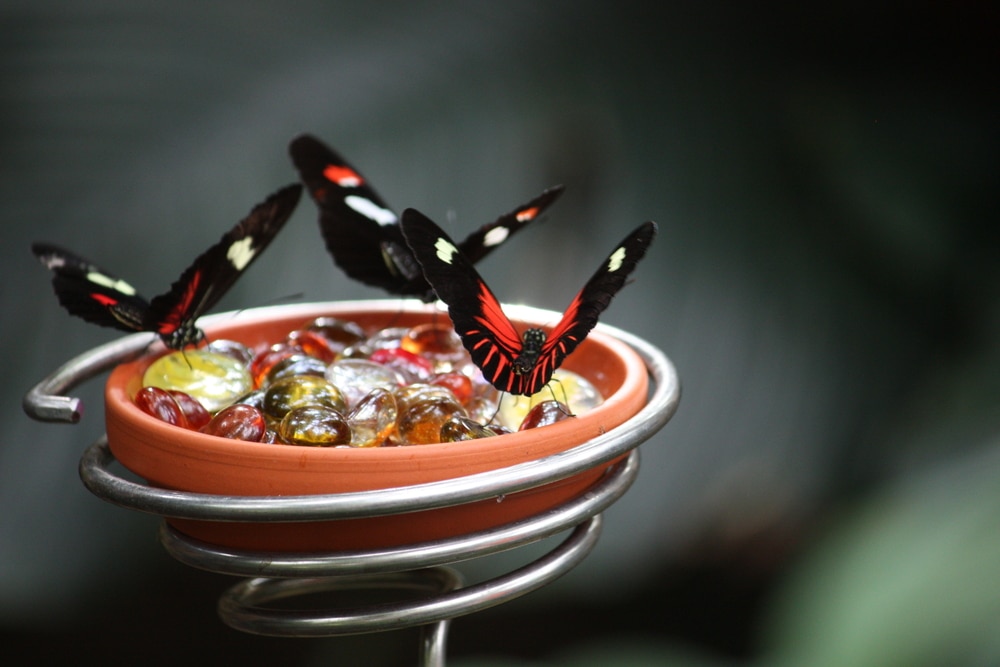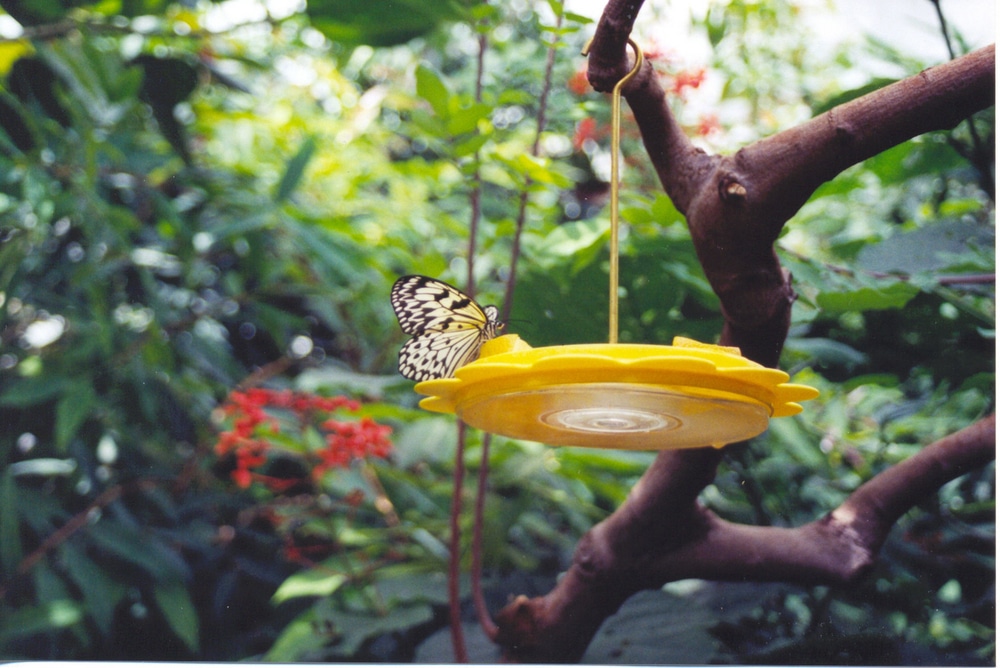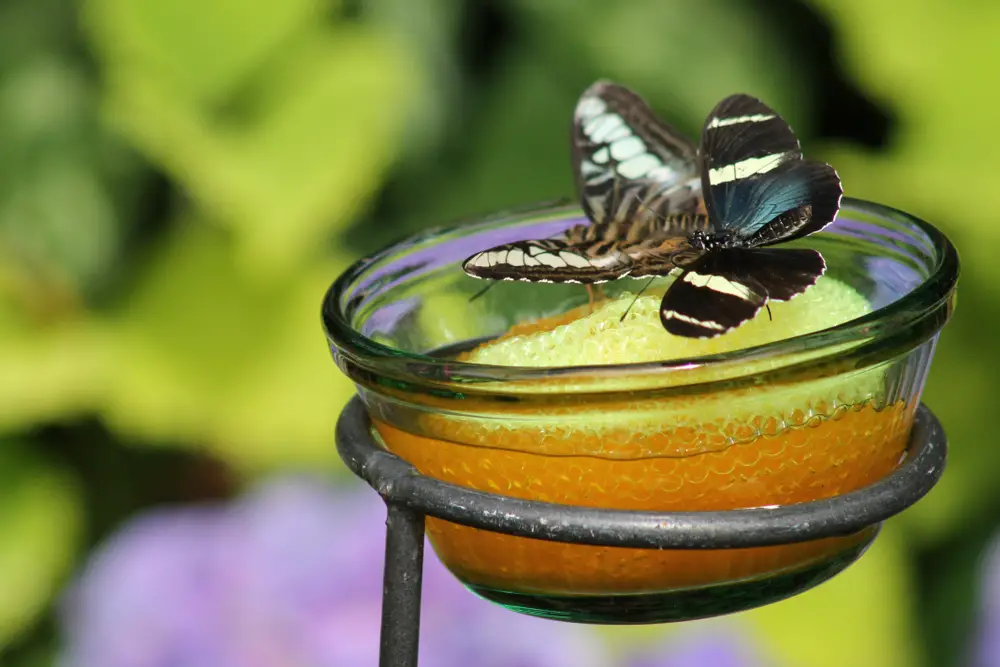Key Takeaways
- Butterfly feeders are simple, colorful devices (usually a shallow plate or sponge) that attract butterflies.
- You can buy butterfly feeders or make them yourself.
- It’s worth considering butterfly feeders since they provide butterflies with food, your garden will benefit from them pollinating it, and butterflies need all the help they can get to thrive.
I love getting up close and personal with nature, and one of the best ways to do that is by inviting wildlife into your backyard. Butterfly feeders are a great choice when you’re looking to attract these pollinating insects, but what exactly is a butterfly feeder?
What Is A Butterfly Feeder?

Butterfly feeders are simple yet effective devices you can put in your garden to attract butterflies. Usually, you fit them with a chain (or similar material to hang them), then hang them so butterflies can easily see and access them.
There are two types: store-bought and DIY.
Store-Bought Butterfly Feeders

Most store-bought butterfly feeders come with a plate or shallow bowl and sometimes a sponge. Some store-bought butterfly feeders also double as a butterfly house. These feeders are typically wooden and feature small slits, just large enough for butterflies to slip into.
Store-bought butterfly feeders draw in many people since they often have beautiful designs and are cost-effective. Some have painted glass plates that reflect light beautifully in the sun, so they’re ideal if you’re looking to boost the aesthetic appeal of your garden and attract butterflies.
DIY Butterfly Feeders

I know many people who want to help their children get better acquainted with nature, and I can think of no better way than to let them help make a DIY butterfly feeder.
This is also a great option for people working on a budget because you can use things you already have at home. Even though most store-bought butterfly feeders are cheap, making a DIY one will save you even more money!
While making a plate-style butterfly feeder at home is possible, most people use an old plastic bottle and some other bits and bobs.
Why You Should Consider A Butterfly Feeder
When I speak to some people, they often think having a butterfly feeder is a waste of time and money. Surely it can’t attract that many butterflies or benefit the garden, right? Well, the opposite is true, and I can think of several reasons a butterfly feeder is well worth considering.
The Chance To Spot Beautiful Butterflies
Having a butterfly feeder means getting to see lots of beautiful butterflies. There are a whopping 17,500 butterfly species worldwide, so you’re sure to spot many different types.
Of course, where you are in the world depends on which species you’ll see, as you can’t find all 17,500 in every location.
For example, you might spot monarchs, common buckeyes, mourning cloaks, and red admirals in North America. Down in South America, you can see the king swallowtail or the blue morpho, while in Europe, the clouded yellow, the short-tailed white, and the cabbage butterfly are all common.
Not only is watching butterflies a relaxing and rewarding experience, but it can also teach you a lot about nature. I have a seven-year-old daughter, and we love being on the lookout for wildlife, so I’m seriously considering getting a feeder to allow her more exposure and to teach her about the importance of pollinators like butterflies.
Providing Butterflies With Food Sources
Sadly, butterflies have suffered dramatically in recent years because of habitat loss. Some of this is due to climate change, but much is because of human development. When we build on meadows, prairies, grasslands, and other wild spots, we’re eating into the habitat of these precious creatures.
In areas with few natural habitats left, providing an alternative food source is a great way to give butterflies the energy they need for pollination.
In fact, you’ll also be doing your local economy a favor since butterflies are some of the primary pollinators of crops like carrots, lettuce, peas, parsnips, and artichokes. Without them, these crops would not have such a good yield.
Your Garden Will Benefit From Pollination
If you’re an avid gardener, having pollinators, such as butterflies, is hugely beneficial to your garden (you can even make a butterfly garden!). They’ll pollinate various fruits and veggies, as discussed above, and many flowers like purple coneflowers, asters, zinnia, and milkweed, to name a few!
For a healthy and thriving garden, there’s nothing more important than allowing nature to do its work.
How To Make A Butterfly Feeder
Making a butterfly feeder at home is a rewarding experience because you’ll feel accomplished and see the results when butterflies visit your work.
To make a butterfly feeder, you will need the following items:
- One old plastic bottle (a soda bottle is ideal, but make sure you keep the cap)
- A line of garden wire, string, or chain
- A sharp object like a pin
- Some sugar syrup as a nectar replacement (mix equal parts water and sugar, boil until the sugar dissolves, then let it cool)
- Scissors or pliers
- A shallow bowl
Start by ensuring you have thoroughly cleaned and rinsed out your plastic bottle; you don’t want anything left behind that might harm the butterflies. Then follow these quick and easy steps:
- Cut a length of your string (or other material) to around 20 cm (7.87 inches).
- Take the string, place the bottleneck in the middle of the length, and tie the string around to secure it.
- Tie or twist the ends of the string to form a loop, which will allow you to hang the feeder.
- Take your pin (you can also use the tip of a slender nail) and pierce two holes in the base of the bottle, keeping them as small as possible.
- Put the bottle into a bowl and fill it with your sugar syrup. Using the bowl during this process will prevent sugar syrup from dripping out of the bottle and making a mess.
- Replace the bottle cap and, keeping the bottle in the bowl, take it to your chosen location.
- Discard the bowl as, once the feeder is in place, you want the sugar syrup to drip freely.
- Hang your butterfly feeder and wait for the butterflies to make an appearance.
Where To Place A Butterfly Feeder
Butterflies generally feed in a sunny spot, but it’s okay if the area receives a little shade each day. However, one of the most important things is to protect the butterflies while they feed.
To this end, I advise choosing a location that isn’t open to strong winds. Moreover, place the butterfly feeder in a spot that isn’t accessible to predators. Remember that bushes or trees will block wind, but they can also provide a hiding place for predators, so balance is essential.

